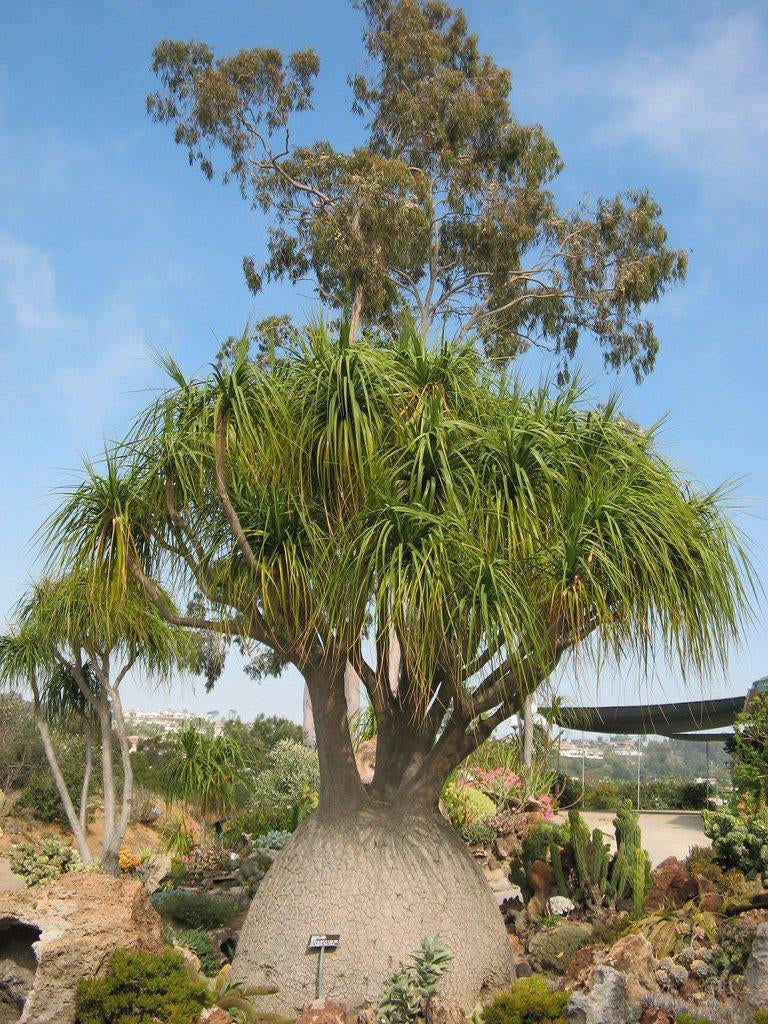
How To Care For Your Ponytail Palm Bonsai Tree
Beaucarnea Recurvata Bonsai Care
About The Ponytail Palm Bonsai Tree
The most striking feature of the Ponytail Palm is the swollen base of the trunk. The closer to the rootball you get, the more bulbous it becomes. The larger the tree gets, the more sudden the bulging base will be.
The scaled and rough texture of the trunk looks and feels scaly like the foot of an elephant, giving it the nickname "Elephant's Foot."
The extraordinary thickening of the trunk serves as a water reservoir against dry spells, allowing the tree to go up to four (4) weeks without water.
This makes it remarkably forgiving as an indoor bonsai tree, suitable for the frequent traveler (or forgetful home gardener.)
Placement
Like most palm trees, a ponytail palm bonsai is tropical. That means it wants to stay warm all year long.
When the outdoor lows are around 50 degrees F, place your ponytail palm bonsai tree on a windowsill indoors. South facing is best, east or west is second best, and you should avoid north if you can (or just use an indoor grow light.)
When the temperatures are above 50 degrees, your ponytail palm bonsai tree can live outdoors.
It loves a TON of sun, so don't feel the need to protect it. Just ensure it's well watered.
Watering
Never let the soil completely dry out. Whenever the soil seems dry, thoroughly water your tree until the water runs clear from the bottom. In the growing season, this can be daily.
If you need help, a good moisture meter will guide you.
Humidity
When your ponytail palm bonsai tree is inside, using a humidity tray is recommended. It will prevent the water from running on the floor, and can help boost the humidity around the tree.
Fertilizing
Since your ponytail palm bonsai is in a small pot, and not the ground, it needs nutrients. A slow release (pellet based) fertilizer is perfect for this, and can be added sparingly every 1-2 months during the growing season.
Pruning & Trimming
Trim back the new growth to the farthest safe point that looks good to you — but never remove all of the new growth.
A regular trim will help keep your ponytail palm bonsai tree short, while helping the trunk grow thicker.
Repotting
Repotting must be performed periodically on your bonsai, ponytail palm included, when its root system has filled the pot. If you can clearly see the roots coming out of the bottom of the pot, it’s time to repot your bonsai.
Generally, this means every 2-3 years for a deciduous tree and every 4-5 years for an evergreen or tropical.
Repotting should be done in mid-summer, when the tree is at it’s least fragile state.
The ponytail palm tree, along with all of its soil, should be removed from the pot. From there, you can trim away no more than 1/3rd of the root mass (1/4th is preferred.)
Then you can repot the tree in the same pot, or give it a newer / bigger pot to thrive in.
After repotting, your ponytail palm bonsai should be thoroughly watered.
Diseases, Insects & Other Pests
Your ponytail palm bonsai can be treated for pests like a normal ponytail palm tree. Just remember, your tree is miniature and will need a much smaller and more gentile dose of treatment.
Would you like to SEE these instructions as a series of videos, instead of just reading them?
If you want to demystify the art of bonsai so you can become a master of this relaxing hobby in just a few days, you need the right training. I’ve built a digital video course that mixes classroom style instructional videos with “over the shoulder” style training videos to make bonsai simple to understand, and easy to start.
In this digital video course, you'll discover:
- How to create a bonsai tree from scratch that will help you experience true inner-peace and calm.
- How to keep your tree collection alive and well so you can enjoy their benefits for a lifetime.
- How to shape your bonsai like a professional, allowing you to design it however you like.
- What bonsai tools you really need and how to use them so you’ll never buy a tool that you don’t need again.
- How to cultivate your own trees so you never have to buy another tree from a store again.
- How to use all of this to create your own bonsai collection so you enjoy this relaxing hobby for the rest of your life.



